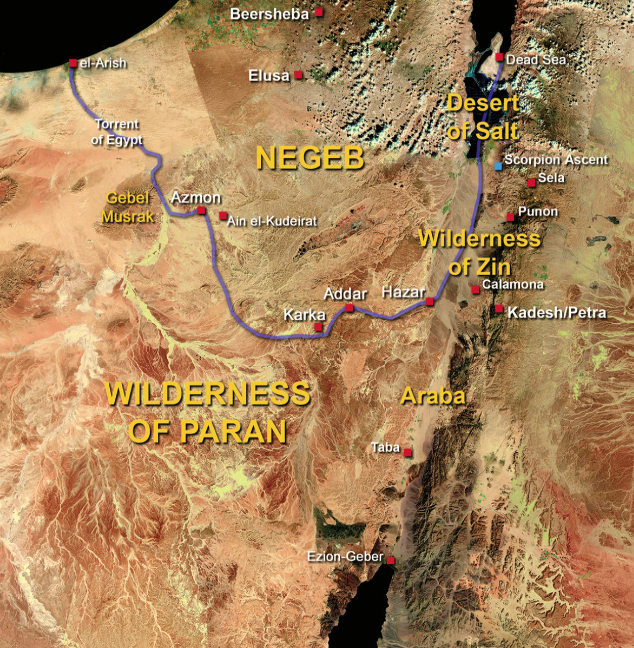The Israelites, the whole community, arrived in the first month (of the third year) at the Wilderness of Zin. The people settled at Kadesh. There Miriam died and was buried.
Numbers 20:1
Moses sent messengers from Kadesh: ‘To the king of Edom, your brother Israel says this: … here we are now at Kadesh – a town on the borders of your territory.
Numbers 20:14-16
They left Ezion Geber and encamped in the Wilderness of Zin – that is at Kadesh. They left Kadesh and encamped at Mount Hor on the borders of the land of Edom.
Numbers 32:36-37
The Amorites, who live in that country of hills, came swarming out against you like bees, pursued you and beat you from Seir to Hormah. On your return, you wept in Yahweh’s presence, but he would not listen to your cries or pay attention. That was why you had to stay at Kadesh as long as you did.’
Deuteronomy 1:44-46
Normally it takes only eleven days to travel from Mount Sinai to Kadesh-barnea, going by way of Mount Seir.
Deuteronomy 1:2
I pointed out in the previous Nugget the fact that it is normal to have many places named after well known or well used toponyms. Bible passages locate Kadesh and Kadesh Barnea in two different deserts, the Wilderness of Paran and the Wilderness of Zin. Both can’t be right unless there are two places. There are seven toponyms named Kadesh in the Levant and two more in Naphthali (Josh 19:37) and Judah (Josh 12:22). Kadesh means in Hebrew “holy” or “holy place”. As we read last week, it is highly likely that we will end up with multiple places called ‘Holy’ given the general meaning of the word. It is natural that many places would have been named ‘holy’ for different reasons. The multiplicity of the name Kadesh and Kadesh Barnea is therefore not at all surprising. There has been huge debate over a long period of time regarding the solution to this problem.
From the above references we learn that the Kadesh where Miriam died was in the Wilderness of Zin on the border of Edom. But hang on, when the spies were sent to reconnoitre the Promised Land, Kadesh appears to be where Moses and the people waited 40 days for their return to the Wilderness of Paran. When the Israelites headed north from Hazeroth they didn’t go straight to Ezion Geber, rather they headed into the Wilderness of Paran (Numbers 12:16). Clearly there is one Kadesh in the Wilderness of Paran and another on the border of Edom. The one in the Paran appears to equate with the Kadesh connected to Hagar (Genesis 16). David Rohl says “the Jerusalem Targum identifies Bered with Khalutsah, the Nabatean city of al-Khalus (Elusa) 19 miles (30 km) southwest of Beersheba. If we stay on the Way of Shur, we would expect to find Kadesh about forty miles southwest of Beersheba. . . So either Ain el-Kudeirat of Ain el-Kadeis could be the Kadesh of Genesis and the Kadesh matching the spies of Exodus.” Page 341 of Exodus – Myth or History.

Many scholars have struggled over the problem of Kadesh located in two different deserts. A careful reading of the biblical text makes it clear that we are not talking about just one place named Kadesh.
Thirty-eight years passed from the time we first left Kadesh-Barnea until we finally crossed the Zered Brook! By then, all the men old enough to fight in battle had died in the wilderness, as the LORD had vowed would happen.
Deuteronomy 2:14
To summarise the journey, when the Israelites left Hazeroth they headed north in the Wilderness of Paran where they sent out the spies from the first Kadesh (Ain el-Kadeis or Ain el-Kudeirat). Having received the report from the spies Moses decided to go into the Promised Land through Edomite and Moabite territory. So the Israelites went down into the Wilderness of Zin and crossed the Araba into Edom where they established their long term camp at Kadesh Barnea. After Miriam died, they headed south to Ezion Geber at the northern point of the Gulf of Aqaba before turning up the pass to the east of Mt Seir into the region of Moab and Ammon. In following this route the people passed by their old long-term camping ground at Kadesh, where Aaron died and was buried on top of Mt Hor, overlooking the Araba in accord with Numbers 33:38.
David Rohl suggests the crucial clue is that Moseroth is clearly the same place as Moserah mentioned in Deuteronomy 10:6. This would mean Moserah was the same place as Mount Hor. The different accounts in Numbers and Deuteronomy appear to be irreconcilable for this part of the journey. They seem to disagree as to when and where Aaron died. Yet both have the Israelites heading south to Ezion Geber and then climbing up onto the Jordan plateau via the Wadi el-Itm Pass. David Rohl suggests adding the word [later] to Deuteronomy 10:6.
The Israelites left the wells of Bene Jaakan for Moserah where Aaron [later] died. He was buried there and his son Eleazer succeeded him in the priesthood.
Deuteronomy 10:6
I will attempt to pull the pieces of this together in the following Nugget and give you a map or maps summarising it all for you. You may well pick up a clue as to where we are headed from the map included above. I am sure it is clear to you that I am relying heavily on David Rohl at this point and I will have more to say about that in the subsequent Nugget. For me the above outline harmonises the discrepancies well for us and certainly solves the multiplicity of Kadeshes.
